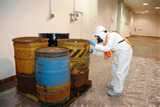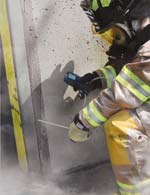The agency has developed a new Web-based tool and interactive map that allows the public to get detailed information by location about the enforcement actions taken at approximately 4,600 facilities.
"This will be the first time code officials, owners, and designers will have an integrated regulatory framework to put into practice that meets the goal of greening the construction and design of new and existing buildings," said Code Council CEO Richard P. Weiland.

The clock is ticking. Companies will have three years from promulgation to come into compliance with the final rule and two years to implement training requirements.

Are user seal checks necessary to ensure protection? And, if so, when should they be performed? A white paper prepared by the American Industrial Hygiene Association's Respiratory Protection Committee asks these and several other questions to resolve important issues.
The standards are designed for anyone involved in pumps, including users, consultants, contractors, construction firms, manufacturers of pumps, seals, motors, instrumentation, controls, and pump software developers and systems integrators.

The nine contracts worth up to $400 million have been awarded by the U.S. Department of Health and Human Services' Biomedical Advanced Research and Development Authority and can lead to prototype devices for responders.
The settlement is expected to reduce sulfur dioxide emissions by almost 35,000 tons per year -- the equivalent to the emissions from 500,000 heavy-duty semi trucks, which is more than all the trucks registered in Indiana, Illinois, Kentucky, and Ohio combined.
As part of a settlement, an alleged violator may voluntarily agree to undertake an environmentally beneficial project related to the violation in exchange for mitigation of the penalty to be paid. This company chose to donate a RAE Systems gas monitoring system and 42 radiation pagers.
The agency's Schools Air Toxics Initiative, which is monitoring the air around 63 schools in 22 states, is checking for several contaminants associated with industrial and mobile sources such as cars, trucks, and airplanes.
As part of a new consent decree, the Arizona-based company said it will continue to remove nitrate and perchlorate from groundwater and perform long-term groundwater monitoring, in addition to paying $.12 million for EPA's past response costs.
The Institute of Food Technologists released three review articles in the Journal of Food Science that were presented at the IFT Annual Meeting in 2009. The articles provide greater detail on nanotechnology science and its application to food.
Specifically, the employer did not evaluate permit-required confined space conditions by testing the atmospheric conditions in the boot pit for oxygen and carbon dioxide levels prior to entry, OSHA said.
The committee's 16 members advise the secretary of Labor on all occupational safety and health matters related to federal employees.
The company's proactive approach toward safety is a model for others to follow," said Charles E. Adkins, OSHA's regional administrator in Kansas City, Mo.

The Fourth National Report on Human Exposure to Environmental Chemicals shows most Americans have measurable levels of many chemicals in their blood or urine, including PFOA, perchlorate, and MTBE.

The department has more than 200 of the units deployed at 102 firehouses and is encouraging all firefighters to obtain level A or B technician certification.
"Few Americans are aware of lead's deadly effects or the fact that lead taken home on clothing and work tools can infect an entire family," said OSHA Area Director Richard Gilgrist in Cincinnati.
Most scientists believe that staph infections are caused by many bacterial cells that signal each other to emit toxins. The signaling process is called quorum sensing because many bacteria must be present to start the process.
OSHA's Philadelphia Area Office initiated the investigation following an ethylene complex explosion in May 2009 at the company's refinery in Marcus Hook, Pa.
The agency began a health inspection in June after receiving information that fires had occurred in the Ohio plant, and that large amounts of dust from the manufacturing process had accumulated throughout the worksite.